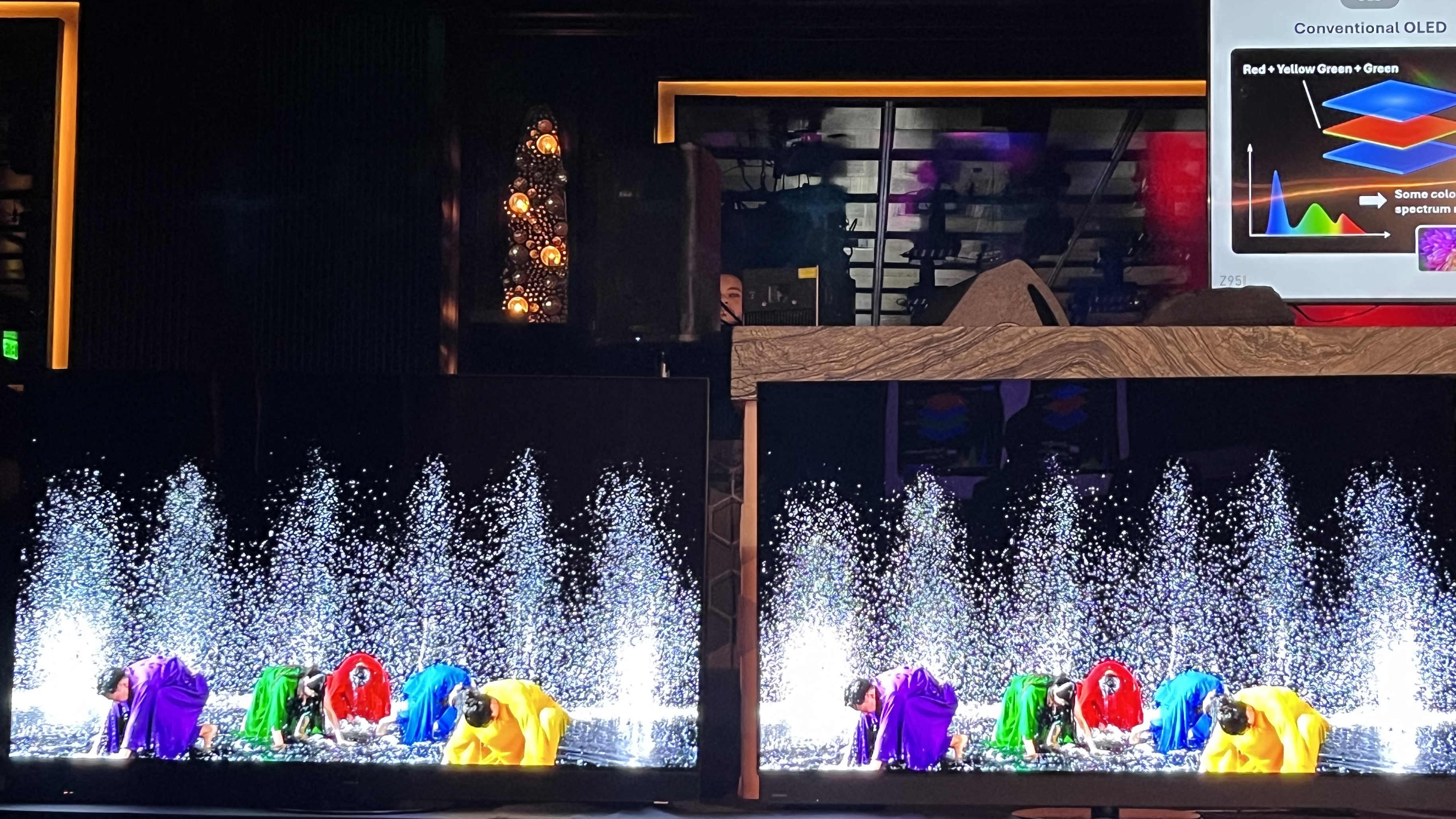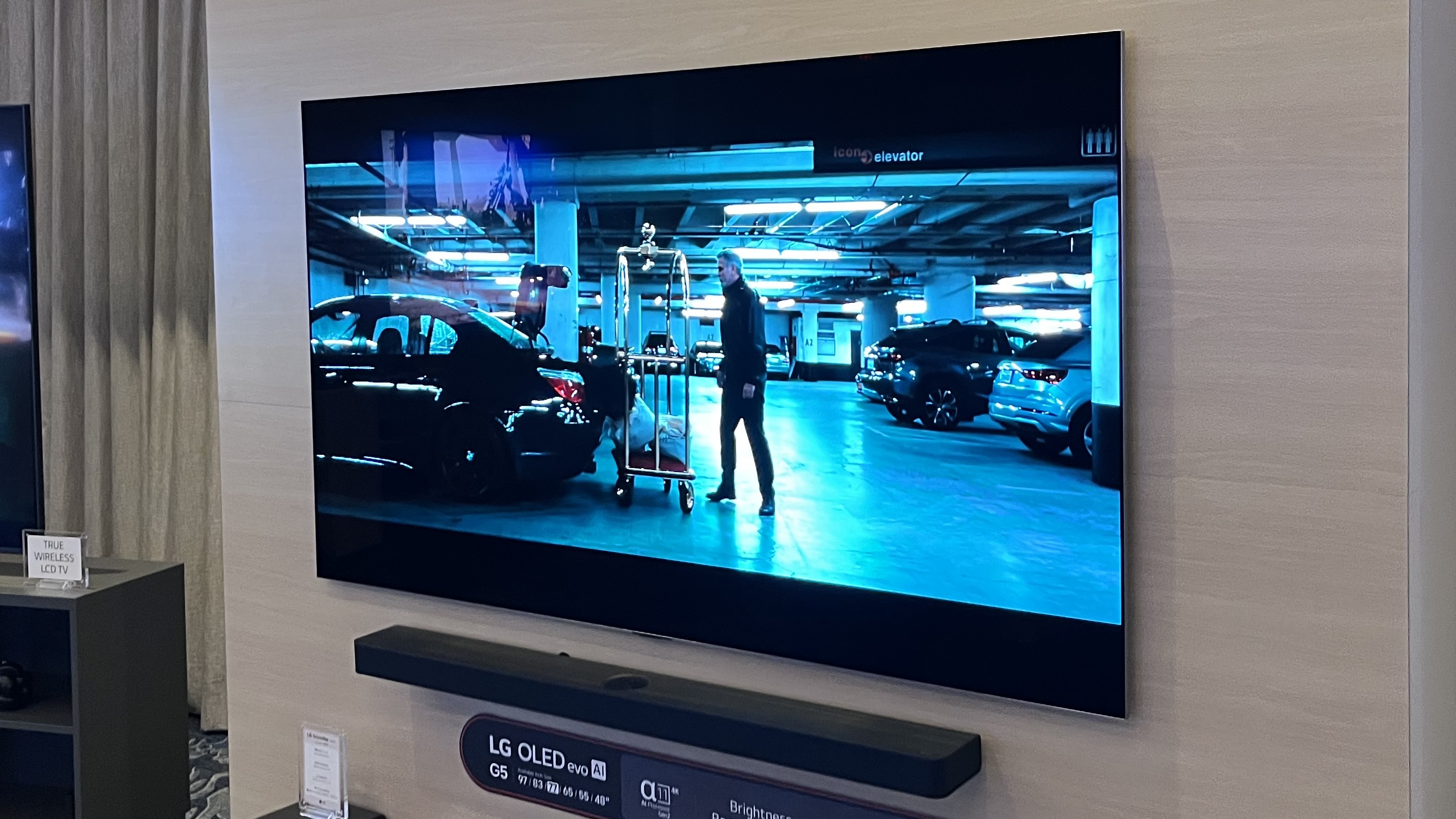LG 'four-stack' OLED TV panel explained: I've seen the dazzling 4,000-nit panel, and here's how it works
Primary RGB Tandem OLED takes a big step into the light

One of the biggest TV developments at CES 2025 was a new fourth-generation 'four-stack' OLED panel developed by LG Display, an independent wing of LG that provides the raw display panels for LG Electronics and other TV makers. LG Display wasn’t exhibiting, but its panel could be found in a new LG G5 OLED TV shown in an off-site preview at the show and in the new Panasonic Z95B OLED, which also uses it.
The specs for LG’s fourth-generation OLED panel are impressive, with a peak brightness of 4,000 nits – 33% brighter than the third-generation 'MLA' panel used in the LG G4 OLED and other TVs. LG Display is also claiming 2,100 nits color brightness, which is a 40% improvement.
It’s unlikely TVs like the LG G5 and Panasonic Z95B will actually yield such high brightness levels in typical use – we measured peak brightness of the LG G4, one of the best OLED TVs and a model specified for 3,000 nits in theoretical use, at just under 1,500 nits in real-world tests. But the prospect of OLED TVs with higher brightness, which LG Display considers “a key picture quality factor because it enables more vivid images that are akin to natural human vision,” is enticing, and it will allow the technology to more effectively compete with the best mini-LED TVs.
Let’s dig into details of LG’s fourth-generation panel to see how it differs from previous OLEDs.
Primary RGB Tandem structure
LG Display calls its fourth-generation panel Primary RGB Tandem structure, which references the individual red, green, and blue OLED layers used to produce light. Previous panels were a three-stack design using two blue layers, with red, green, and yellow elements combined in a third layer. In the third-generation panel, this was augmented with a micro lens array (MLA) layer that uses microscopic lens elements to boost light output from the panel.
In the new design, red and green layers are sandwiched between two blue layers. This four-stack structure serves to increase overall light output, and is effective enough that an MLA layer is no longer needed or used. The separation of red, green, and blue elements also enhances color purity and is responsible for the fourth-generation panel’s color brightness increase.
Higher brightness is typically associated with higher power consumption, but LG Display claims that its new panel design has “around 20% greater energy efficiency than the previous generation (in the case of a 65-inch panel).” According to the company, this was achieved through enhancements to the panel’s power supply system, and it’s expected to compensate for the higher power consumption needs brought about by AI features for picture processing and other automated tasks.
Get daily insight, inspiration and deals in your inbox
Sign up for breaking news, reviews, opinion, top tech deals, and more.
The third-generation LG Display panel used in OLED TVs such as the LG G4 did a very good job maintaining solid black levels even in well-lit rooms, something I confirmed in a comparison between the G4 and the Samsung S95D. For the fourth generation panel, LG Display has added “ultra-low reflection technology,” which is a screen coating that “offsets both light reflected from the display’s surface and light absorbed and reflected inside the panel.”
According to the company, ultra-low reflection technology blocks 99% of screen reflections while maintaining “perfect blacks” even when viewing in daylight conditions. Furthermore, LG Display says its new panel can maintain 100% color accuracy in such conditions, making it “the only display to overcome the viewing environment limitations of conventional displays.”

OLED without limits
Having spent many years in the trenches testing TVs, I can confirm that the best TVs get brighter every year. Up until recently, OLED models lagged well behind mini-LED ones when it came to both peak and fullscreen brightness, but tech developments such as MLA and Samsung Display’s QD-OLED, which combines an OLED panel with a quantum dot layer, have allowed OLED TVs to play catch-up.
The new LG G5 and Panasonic Z95B are high-end models and they will sell for a premium price. But to judge from what we saw at CES 2025, these new flagship OLED TVs will deliver more than satisfactory brightness, enabling a full array of highlight detail in 4K movies and TV shows with high dynamic range, and also providing sufficiently bright and high-contrast pictures when viewing in rooms with a high level of ambient lighting.
In past years, that level of flexibility was exclusive to the best mini-LED TVs, but it now looks like OLED TVs have finally leveled the playing field. And with mini-LED backlighting tech making steady year-on-year improvements, in the best cases yielding OLED-like black level and shadow detail performance, it couldn’t come at a better time for OLED.
You might also like...

Al Griffin has been writing about and reviewing A/V tech since the days LaserDiscs roamed the earth, and was previously the editor of Sound & Vision magazine.
When not reviewing the latest and greatest gear or watching movies at home, he can usually be found out and about on a bike.
You must confirm your public display name before commenting
Please logout and then login again, you will then be prompted to enter your display name.
